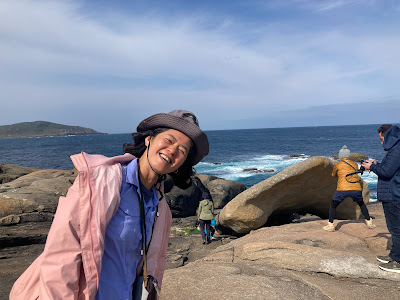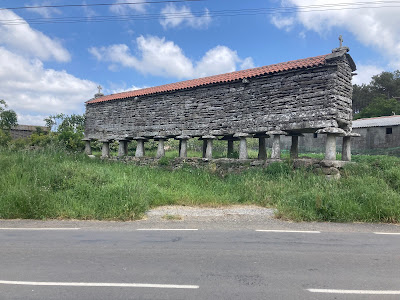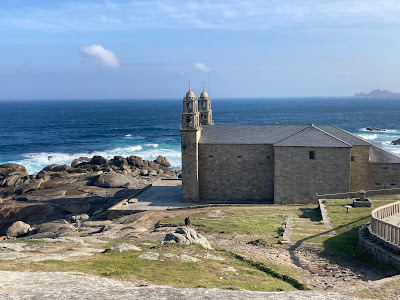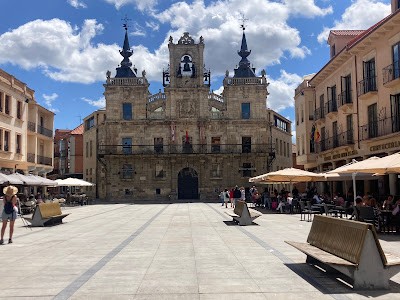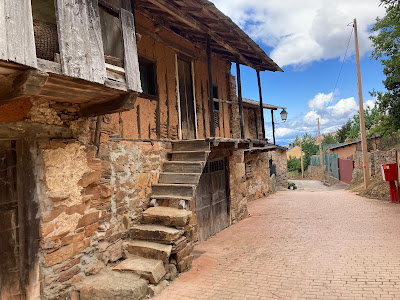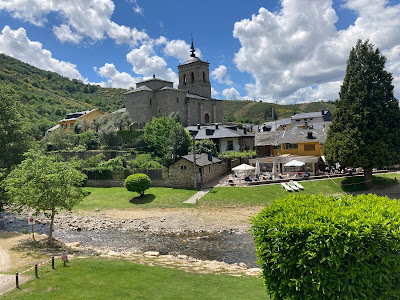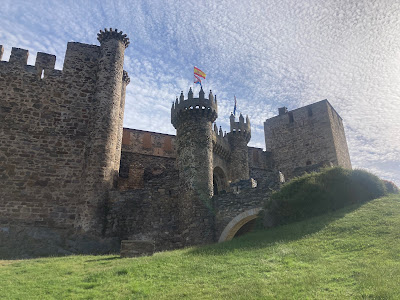It was great to be back in Santiago, a city I am somewhat familiar with. I don’t get lost too often now that I have visited the city after each Camino, but it still happens. The walking center of the city is mostly narrow streets and alleyways that usually don’t go in a straight line. You discover new ways to get back to your hotel just about every time you go out. In the limited time that I was with Kelly, I was amazed on how well she knows the city. Of course she has been there numerous times with her tour groups. And she knows the people. Cafe baristas, restaurant owners, store keepers and the all important volunteers at the Pilgrims Office. Giving her double cheek kisses upon seen her. I think she is making a name for herself in the tourist industry.
KELLY AT THE END OF THE EARTH
Santiago is also wonderful for seeing old friends, as in Jose from Portugal, or pilgrims you met along the way. Conversations start easily in a city full of pilgrims and tourists. Someone sits at a table next to you in a restaurant, “Did you walk? How far? Where did you start? Or someone asking about your Camino. In a crowded restaurant in the city’s marketplace, Joaquín, a expatriate from Mexico living in New York City was seated next to Kelly and I while having lunch. Conversation ensued and the lunch stretched into 2-1/2 hours. This seems to be common place in Spain as meals with good conversation go slowly. Normally the midday meal starts around 1:30 or 2, with dinner being served after 8:00. Many restaurants close after lunch and reopen at dinner time. It is a different way of eating…..slowly.
JOAQUIN
But I didn’t end my Camino in Santiago. Changing up the schedule on the fly gave me an opportunity to see old friends in Santiago and continue walking to the coast. Also I needed a break after only having one rest day since the Pamplona. There are two destinations to choose from on the coast, Finisterre or Muxia, known as the End of the Earth back in the day. Some walk to both and then walk back to Santiago. I have previously been to both locations by bus and car. Finisterre is the traditional place where pilgrims walk to but I chose Muxia because it is more scenic in my opinion. Also and important factor to me is that fewer pilgrims choose Muxia and I wanted time to walk without seeing so many pilgrims. Services for pilgrims are fewer so you do see more pilgrims at the limited albergues where you can stay, but few on the path.
So, four more days of walking adding a tad over 50 miles, through forests, and up and down a bunch of hills. And it was very peaceful walking on pathways where I saw hardly anybody.
I noticed that the pilgrims that I do see are different than those I saw before Santiago. There were four of us at an albergue, the only pilgrims and we were discussing this difference over dinner. Each of us had walked previous pilgrimages and we all agreed that many of the pilgrims we see and meet are different than those of previous times. I have mentioned before here and on Facebook, that I have encountered rude pilgrims in bars and albergues. The others at the table concurred that the Camino has changed. Perhaps because the Camino was shut down during Covid and now there is a rush of people wanting to walk. We also agreed that many of today’s pilgrims aren’t pilgrims at all, but tourists.
So now I am in Muxia for a few days, staying in a small apartment with the all important washing machine. You grow to appreciate having clean clothes. And now the feet can rest and heal. Actually since I walked most of the Camino in my sandals my feet have been pretty happy, but one of the sandals is about to give up. Just hoping it will last till I get home.
MUXIA
Muxia has a population of around 4700 people and has a small boat harbor. Fishing is an important part of the community and fresh fish is readily available in the local restaurants. Sea food offerings take up most of the space on menu and beef, pork and chicken take a back seat. There is a church at the end of the world in Muxia. Santuario da Virginia da Barca sits on the rocks facing the ocean. Inside there are models of ships and fishing vessels. Built in the 17th century, it was destroyed by fire after being stuck by lightning on Christmas Day in 2013. The monolith on the hill above the church represents the lightning bolt.
So, the Camino ends or does it? Every Camino is different and this, possibly my last, will be etched in my memory in both positive and negative ways. I really had the sense of being alone this time, and I consider that a positive. Really the only negative were the few pilgrims who by their actions spoil the camaraderie I felt on past Caminos. They were the tourists. The last 4 days were the most enjoyable in two ways. Seeing no one on the path for hours, but having great conversations in the evenings over dinner. Nicole, from France, Laura, from Spain, and Alex and his wife Adriane from Germany. These pilgrims restored my faith that this is a pilgrimage and not just an excursion for tourists. They are the true pilgrims.
In a few days I will start my journey home. Back to Santiago by bus, train to Madrid then the flight home. I miss home and it’s comforts, but most I miss Cathie. It will be good to be back.
In case you ask, 395 miles, not counting looking for a bar.
EARLY MORNING LIGHT
